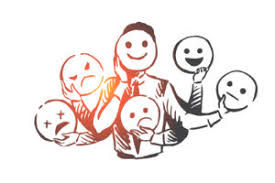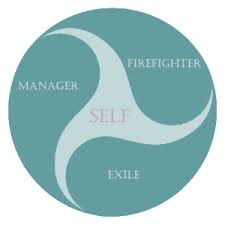Last post I promised to share some ideas for breaking the feedback cycle of addiction. Today I want to suggest a three-part intervention strategy for doing just that. In a nutshell, (1) tune into your emotions, (2) see what “parts” (in IFS terms) those emotions belong to, and (3) help those parts calm down and work together. Help them to understand each other rather than disrupt and hurt one another.
[Please note that I’ve revised this from its original form, posted two weeks ago — 8th November]
This little three-part exercise can be led by a therapist or coach or else pursued solo. Note that this is not classical IFS therapy (which I’m still studying). Rather, it’s a hybrid I’m playing with and continuing to explore. It’s by no means a nicely packaged and approved therapeutic system. Rather, it may point to an approach for helping people who need more direction and guidance (more “coaching”) than IFS normally provides.
Over the past year, and using IFS principles more and more, Maya and I explored the conflictual relationships among her parts. Besides Madam Z, the internal critic, and Piya, the “firefighter,” Maya’s parts  included a very sad girl who could not give up her preoccupation with the tragedy of her life (which hinged on her mother’s rejection and self-denigration). Much of Maya’s internal conflict triggered excessive waves of grief and self-rebuke. It would take up too much time and space to explore these themes in a blog post. It took a lot of time to discover them in therapy. But meanwhile, Maya kept drinking large amounts of cheap wine, almost every night, wrecking her health, and reinforcing her sense of hopelessness. It seemed urgent to find an exercise that could help, with me or without me, starting now.
included a very sad girl who could not give up her preoccupation with the tragedy of her life (which hinged on her mother’s rejection and self-denigration). Much of Maya’s internal conflict triggered excessive waves of grief and self-rebuke. It would take up too much time and space to explore these themes in a blog post. It took a lot of time to discover them in therapy. But meanwhile, Maya kept drinking large amounts of cheap wine, almost every night, wrecking her health, and reinforcing her sense of hopelessness. It seemed urgent to find an exercise that could help, with me or without me, starting now.
So this is what we came up with:
1.Tune into your feelings — your emotions — as they come and go. (Starting with deep breathing and body awareness is helpful!) This is mostly just standard Buddhist “Vipassana” meditation — the practice of paying attention to whatever arises. But it’s directed toward feelings more  than perceptions, thoughts, and bodily sensations. Follow the emotions, surf them, watch them come and go, don’t think about them too much. You might expect oodles of shame and anxiety. Practice your ability to discern, because some of these emotions might be so common that they seem like background noise. There may also be streaks of unexpected emotions, such as bolts of anger when you thought you were generally “nice”. With emotions like anger and fear, which have a definite object, try to be aware of who/what that object is. Is it self or other? Stay at the surface of awareness. Don’t “go deep.” Let the emotions come to you. You don’t have to go hunting.
than perceptions, thoughts, and bodily sensations. Follow the emotions, surf them, watch them come and go, don’t think about them too much. You might expect oodles of shame and anxiety. Practice your ability to discern, because some of these emotions might be so common that they seem like background noise. There may also be streaks of unexpected emotions, such as bolts of anger when you thought you were generally “nice”. With emotions like anger and fear, which have a definite object, try to be aware of who/what that object is. Is it self or other? Stay at the surface of awareness. Don’t “go deep.” Let the emotions come to you. You don’t have to go hunting.
 2. Notice that each emotion may be felt by one or more parts. Which part is revving up now? Anger might go with the harsh internal critic, but anger might also go with the defiant “fuck you” rebel part. Get a sense of which part is becoming activated. Shame probably goes with a very young part — perhaps a part that (in IFS terms) remains an exile…not fully conscious, perhaps actively shunned or rejected. Anxiety also may be felt by young “exiles” — cringing, alone, scared, helpless — or by “managers” (e.g., parts who organize, take care, or judge) when they sense that they’re losing control. These managers can also be young. (A deeper discussion of what these parts actually are has to await a later post.)
2. Notice that each emotion may be felt by one or more parts. Which part is revving up now? Anger might go with the harsh internal critic, but anger might also go with the defiant “fuck you” rebel part. Get a sense of which part is becoming activated. Shame probably goes with a very young part — perhaps a part that (in IFS terms) remains an exile…not fully conscious, perhaps actively shunned or rejected. Anxiety also may be felt by young “exiles” — cringing, alone, scared, helpless — or by “managers” (e.g., parts who organize, take care, or judge) when they sense that they’re losing control. These managers can also be young. (A deeper discussion of what these parts actually are has to await a later post.)
Note that anxiety will usually not be experienced by firefighters. They are more reckless, and they tend to feel excitement, desire, or triumph. Notice that parts are sometimes very stuck (unchanging); other times more fluid and perhaps even growing, evolving before your eyes. Notice how some parts reliably trigger other parts. It’s very common for the firefighter (let’s get drunk!) to trigger the internal critic (how could you?! After last night!?!). And vice versa — but that needs to be saved for a future post too.
 3. The last step is to act on this internal world, i.e., to guide it as it evolves and changes. This way of framing things deviates from IFS orthodoxy, but the underlying goal and the net effect could be almost identical. Now comes the sense of being a coach…or even a parent. IFS stresses the power of the Self — “Self” with a capital “S”. That’s the part that’s not a part. The Self is viewed as a compassionate, perceptive and aware place within oneself — a centre — that recognizes and accepts the various parts along with their needs and concerns (e.g., their emotions,
3. The last step is to act on this internal world, i.e., to guide it as it evolves and changes. This way of framing things deviates from IFS orthodoxy, but the underlying goal and the net effect could be almost identical. Now comes the sense of being a coach…or even a parent. IFS stresses the power of the Self — “Self” with a capital “S”. That’s the part that’s not a part. The Self is viewed as a compassionate, perceptive and aware place within oneself — a centre — that recognizes and accepts the various parts along with their needs and concerns (e.g., their emotions,  their goals). So, from this place, you can soothe the anxious child, comfort him or her so there won’t be so much loneliness or dread. You can also connect with the Firefighter, and coax it (in a friendly way) to relax, to look before leaping for that bottle or that pipe. You can help antagonistic parts disengage, lay down their arms for awhile. For example, judging, critical parts can be asked to back off: we can tell them we appreciate their vigilance, but they’re coming on too strong and it’s not helping (e.g., too much shame, augmenting the Firefighter’s urge to drink or take drugs).
their goals). So, from this place, you can soothe the anxious child, comfort him or her so there won’t be so much loneliness or dread. You can also connect with the Firefighter, and coax it (in a friendly way) to relax, to look before leaping for that bottle or that pipe. You can help antagonistic parts disengage, lay down their arms for awhile. For example, judging, critical parts can be asked to back off: we can tell them we appreciate their vigilance, but they’re coming on too strong and it’s not helping (e.g., too much shame, augmenting the Firefighter’s urge to drink or take drugs).
The parts can also act on each other directly. For example, Maya’s internal critic, Madam Z, is conscientious and determined. Her eagle eye is tuned to drinking behaviour and related cues, especially late in the afternoon, and she’s full of suggestions as to how to override the urge. “Wouldn’t this be a good time to start your yoga? Stop thinking about the store’s closing hours!” Maya came to realize that Madam Z wasn’t always punitive. Sometimes she was more like an athletic coach, authoritative but supportive. And she gradually learned to use Madam Z’s industrious, exacting manner to organize her behaviour and negotiate with other parts — especially the firefighter, who only wants to drink. Wait! There’s more to do. You don’t have to start drinking now. You can drink as a reward after completing your assignment.
It seems to me (though it deviates from IFS orthodoxy) that this internal “friendliness” can be understood as a continuum or spectrum of self-care, with soothing or compassion at one end and firmness or self-direction — let’s call it guidance — at the other end. As with good parenting, a balance is needed. IFS suggests that different parts (as well as the capital-s Self) flesh out that continuum, from one pole to the other. In fact, in the mysterious language of the internal landscape, it may be the sense of “we” that’s most beneficial. Parts often feel alone — and in that they are relatively helpless, bound by habits they’re not skillful enough to overcome. But once there’s a we involved — a source of care that’s bigger than just this present-tense state of drive, this wish, this moment — they can feel taken care of, they can feel stronger, more secure, and they can more effectively promote their own well-being.


 The first and perhaps biggest step is to start a dialogue with the part of us that does the escaping. They call it the Firefighter, because its job is to put out the fire of anxiety and self-abuse, as quickly and as effectively as possible, with no regard for the mess it leaves behind. We’re used to reviling that part: that pernicious, irresponsible urge to get loaded, high, smashed. That part is almost always the object of criticism (both from ourselves and from others).
The first and perhaps biggest step is to start a dialogue with the part of us that does the escaping. They call it the Firefighter, because its job is to put out the fire of anxiety and self-abuse, as quickly and as effectively as possible, with no regard for the mess it leaves behind. We’re used to reviling that part: that pernicious, irresponsible urge to get loaded, high, smashed. That part is almost always the object of criticism (both from ourselves and from others). Wearing her sexiest clothes, with a cigarette dangling from her lips, she’d hang out with other teens on the street corner. There was drinking, and smoking, cannabis, and sex. Piya took over at night, with the express purpose of having fun, feeling free, and saying Fuck You! to the authorities that ruled Maya’s life.
Wearing her sexiest clothes, with a cigarette dangling from her lips, she’d hang out with other teens on the street corner. There was drinking, and smoking, cannabis, and sex. Piya took over at night, with the express purpose of having fun, feeling free, and saying Fuck You! to the authorities that ruled Maya’s life. In our therapy, guided by IFS principles, I encourage Maya to do two things: first, notice that Piya is made to feel dirty and blameworthy by a critical voice in her own head. She calls the critical part Madam Z (…not her real made-up name. Yes, even internal voices need pseudonyms) who has the character of a strict school teacher or aunt. Madam Z has much to contribute. We don’t want to banish her. But we don’t need her badgering Piya every time she appears. The second thing is to engage with Piya, not from the perspective of Madam Z but from the perspective of
In our therapy, guided by IFS principles, I encourage Maya to do two things: first, notice that Piya is made to feel dirty and blameworthy by a critical voice in her own head. She calls the critical part Madam Z (…not her real made-up name. Yes, even internal voices need pseudonyms) who has the character of a strict school teacher or aunt. Madam Z has much to contribute. We don’t want to banish her. But we don’t need her badgering Piya every time she appears. The second thing is to engage with Piya, not from the perspective of Madam Z but from the perspective of  Maya’s peaceful, accepting self. Her compassionate core — what IFS calls Self with a capital-S. That Self becomes more present, more tangible, when Maya takes a few minutes to do some deep breathing, to feel what it’s like simply to be inside her own body, alive and perceptive. Ironically or mysteriously, this Self may the same thing as
Maya’s peaceful, accepting self. Her compassionate core — what IFS calls Self with a capital-S. That Self becomes more present, more tangible, when Maya takes a few minutes to do some deep breathing, to feel what it’s like simply to be inside her own body, alive and perceptive. Ironically or mysteriously, this Self may the same thing as  To forgive and embrace the part that’s simply waiting for a chance to get stoned…that’s radical. It flies in the face of conventional approaches to addiction, which demand that we get rid of this part, cast it out, or at least ignore it until it finally shuts up. So what’s the result? Doesn’t that just give us permission to get stoned more often, to drink more, to fully surrender to the addictive impulse? To do more push-ups in the parking lot (an infamous 12-step slogan).
To forgive and embrace the part that’s simply waiting for a chance to get stoned…that’s radical. It flies in the face of conventional approaches to addiction, which demand that we get rid of this part, cast it out, or at least ignore it until it finally shuts up. So what’s the result? Doesn’t that just give us permission to get stoned more often, to drink more, to fully surrender to the addictive impulse? To do more push-ups in the parking lot (an infamous 12-step slogan).


 What are these parts? Maybe you’ve thought of them as voices, or selves, or subpersonalities — it doesn’t matter. They appear as habitual perceptions or expectations with distinct emotional loadings (e.g., anxiety, anger, longing) — and they can be intrusive in the background or they can seem to take over.
What are these parts? Maybe you’ve thought of them as voices, or selves, or subpersonalities — it doesn’t matter. They appear as habitual perceptions or expectations with distinct emotional loadings (e.g., anxiety, anger, longing) — and they can be intrusive in the background or they can seem to take over. overtakes the system, it has no regard for tomorrow, and it’s very difficult to resist. In AA, it’s said to be doing push-ups in the parking lot. In psychology jargon, it’s called compulsion. NIDA calls it a diseased brain. But I don’t find any of these concepts at all helpful. From a neuroscience perspective, I can point to the part of the brain that “does” compulsion — the dorsolateral striatum — but all that’s really doing is putting a habit into play. And as we know, addictive urges are all about habit. So what happens if we consider this to be a part of a person that is young, energetic, one-track minded, and determined to overcome negative emotion in the only way it knows how? When you think about it that way, it’s hard to negate it or to hate it.
overtakes the system, it has no regard for tomorrow, and it’s very difficult to resist. In AA, it’s said to be doing push-ups in the parking lot. In psychology jargon, it’s called compulsion. NIDA calls it a diseased brain. But I don’t find any of these concepts at all helpful. From a neuroscience perspective, I can point to the part of the brain that “does” compulsion — the dorsolateral striatum — but all that’s really doing is putting a habit into play. And as we know, addictive urges are all about habit. So what happens if we consider this to be a part of a person that is young, energetic, one-track minded, and determined to overcome negative emotion in the only way it knows how? When you think about it that way, it’s hard to negate it or to hate it. for the last week or the last month. We often call this the internal critic, and its specialty is self-blame and self-contempt. So what happens if we see this part as a younger version of ourselves, who learned to be our caretaker or disciplinarian? You better be good! Don’t you dare goof up again! You’re going to be in real trouble if you do that!! Once we see this part as trying to help keep us out of trouble, it’s hard to feel alienated from it or even victimized by it. Instead, IFS asks us to open a dialogue with this part. For example: You come out whenever I’m likely to do something “bad” (like call my dealer), don’t you — I guess that’s been a full-time job lately. But then you get so upset with me that I get seriously depressed, and then I just want to get high all the more. Let’s try reducing the pressure a bit.
for the last week or the last month. We often call this the internal critic, and its specialty is self-blame and self-contempt. So what happens if we see this part as a younger version of ourselves, who learned to be our caretaker or disciplinarian? You better be good! Don’t you dare goof up again! You’re going to be in real trouble if you do that!! Once we see this part as trying to help keep us out of trouble, it’s hard to feel alienated from it or even victimized by it. Instead, IFS asks us to open a dialogue with this part. For example: You come out whenever I’m likely to do something “bad” (like call my dealer), don’t you — I guess that’s been a full-time job lately. But then you get so upset with me that I get seriously depressed, and then I just want to get high all the more. Let’s try reducing the pressure a bit. many times a day do you suppose the average 6-year-old thinks about NOT getting in trouble? How many times did you do bad shit anyway? The trouble now is that those two parts are so busy trying to shut each other down that you can’t get anywhere. Neither part will stop doing what it’s doing. It all seems so hopeless.
many times a day do you suppose the average 6-year-old thinks about NOT getting in trouble? How many times did you do bad shit anyway? The trouble now is that those two parts are so busy trying to shut each other down that you can’t get anywhere. Neither part will stop doing what it’s doing. It all seems so hopeless. Having practiced IFS as a therapist now for several months, I am sold on its efficiency and its power. (I’ve even begun as a client, myself, with an IFS therapist. What better way to learn the ropes…not to mention some timely self-improvement.) My clients “get it” almost at once. I don’t have to sell them on the rather esoteric imagery and jargon. They just take a look inside and say, Um yeah, that’s pretty much what’s happening. And then they start to change.
Having practiced IFS as a therapist now for several months, I am sold on its efficiency and its power. (I’ve even begun as a client, myself, with an IFS therapist. What better way to learn the ropes…not to mention some timely self-improvement.) My clients “get it” almost at once. I don’t have to sell them on the rather esoteric imagery and jargon. They just take a look inside and say, Um yeah, that’s pretty much what’s happening. And then they start to change.